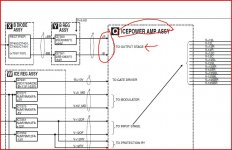thought so too could be the error. Therefore I bought brand new B REG ASSY board. Unfortunately, there is no difference.
The output you have selected is supply to the motherboard and not ICE ASSY.
ICE ASSY has its own supply from the transformer;
The output you have selected is supply to the motherboard and not ICE ASSY.
ICE ASSY has its own supply from the transformer;
Yes you are right. But I have not be able to measure any short circuit to ICE AMP. Nor have I could see anything visibly damaged. How can it still blow the fuses at B REG when I unplug the cable to ICE AMP...?
😕
😕
Does it blow the fuses if you disconnect the feed from the regulator board ? You say you disconnected the leads to the ICE power board. You should be able to measure continuity from the regulator direct to the plug/s you disconnected. That's a check that you have isolated the correct feeds
You are going to have to physically look and measure where the output from the reg goes. Its far to complex a service manual to just navigate on a screen.Its possible for the problem to be a low impedance failure and not a dead short, for example if one transistor in the output pairs was faulty on one of the 5 (is it 5?) channels. That wouldn't read as a short across any rail but would draw excess current when powered and blow the fuses.
You are going to have to physically look and measure where the output from the reg goes. Its far to complex a service manual to just navigate on a screen.Its possible for the problem to be a low impedance failure and not a dead short, for example if one transistor in the output pairs was faulty on one of the 5 (is it 5?) channels. That wouldn't read as a short across any rail but would draw excess current when powered and blow the fuses.
Its hard when its such a massive service manual viewed on a laptop screen 😉
Listen 🙂... you said yourself that it met its demise after playing loud music for a fun night. That alone points to the output stages and overload damage.
Listen 🙂... you said yourself that it met its demise after playing loud music for a fun night. That alone points to the output stages and overload damage.
you're right. It is most logical output transistor. But could one capacitor be enough to the error?
I'm not following you on that.
Do you mean could a capacitor cause the fuse blowing... yes... there are probably many caps that could cause those fuses to blow (and not just caps across the rails) but also caps that could alter the biasing of the output stage and so on. Its just not very likely as a first line of attack given the units timeline in the run up to the fault.
Do you mean could a capacitor cause the fuse blowing... yes... there are probably many caps that could cause those fuses to blow (and not just caps across the rails) but also caps that could alter the biasing of the output stage and so on. Its just not very likely as a first line of attack given the units timeline in the run up to the fault.
Hi,
I asked you to check the resistance at the fuse load side. Can you do the check it will tell you if the short it is before or after the regulator transistor.
I asked you to check the resistance at the fuse load side. Can you do the check it will tell you if the short it is before or after the regulator transistor.
Hi,
If the resistance at the fuse load side it is high then can you check the resistance at the CN7303 pin 1.
If the resistance at the fuse load side it is high then can you check the resistance at the CN7303 pin 1.
I think I have found the error. There were 2 mosfet which was blowen in ICE ASSY. I replace them and write back when I know it was the only mistake.
- Status
- Not open for further replies.
- Home
- Amplifiers
- Solid State
- Pioneer sc-lx71 blowing fuses
